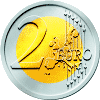| The Latin Monetary Union |
| Home |
Italian Euro coins
1 euro = 1,936.27 lire
The following coins are legal tender
since January 1, 2002. No Italian Euro coins
were struck
for circulation with the dates 1999, 2000 or 2001, while other
European countries have done so.
Some 20c pieces were struck
by mistake with the date 1999 and, although they
were to be melted, a few
escaped illegally from the Mint. Buying or selling these coins is illegal.
Banknotes are the same for all
Euro countries, but it is possible to determine the country that has issued
the banknote by looking at the first letter of the alphanumerical identification
code.
Here is the list of the letters
referring to each State of the Union.The list includes the letters that
U.K, Denmark and Sweden will use if they will decide to join the monetary
union.
L=Finland, P=Netherlands, T=Ireland, Y=Greece, J=United Kingdom, M=Portugal, R=Luxemburg, U=France, X=Germany, K=Sweden, N=Austria, S=Italia, V=Spain, Z=Belgium and W=Denmark
For an overview and updated info about euro coins check this site:
Euro Master: on-line numismatic catalog of euro coins
The common side of Euro coins was designed by: Luc Luycx
2 Euro
Metal: Copper - Nickel - Brass
Diameter: 25.75 mm
Engraver: Maria Carmela Colanieri


Dante Alighieri's portrait. Dante (b. 1265- d.
1321) is considered to be the father of Italian language. His De Vulgari
Eloquentia and of course the Divina Commedia (Divine Comedy),
established
Italian vernacular as literary language replacing latin.
Dante's portrait on this coin, is taken from Raffaello's
Parnaso,
a fresco situated in the Vatican's rooms of Pope Giulio II.
1 Euro
Metal: Copper - Nickel - Brass
Diameter: mm 23.25
Engraver: Laura Cretara


Leonardo Da Vinci's drawing
(called the Vitruvian man) based on a study of human proportions. The
drawing, not dated but probably made on 1490 AD, is situated in the Gallerie
dell'Accademia di Venezia.
Leonardo (b. 1454 Vinci, Republic of Florence - d. 2
May 1519 Coux Fr.) was simply a genius: painter, draftsman, sculptor, architect,
and engineer. His Mona Lisa and the Last supper were among
the most influential paintings of the Renaissance, while his spirit of
scientific inquiry and mechanical inventiveness were centuries ahead of
his times.
50 Centesimi
Metal: nordic gold
Diameter: mm 24.25
Engraver: Roberto Mauri


Roman bronze statue of Marcus Aurelius,
placed in Piazza del Campidoglio (Campidoglio's square) in Roma by
Pope Paulus III in 1538. The original statue, now replaced by a copy, is
in the Musei Capitolini (Roma) .
Marcus Aurelius (b. 121 AD- d. 180 AD) was one of the
greatest Roman emperors of the Imperial Golden Age , also known for his
Meditations
on Stoic philosophy.
20 Centesimi
Metal: nordic gold.
Diameter: mm 22.25
Engraver: Maria Angela Cassol


Boccioni's sculpure: Unique
Forms of Continuity in Space (1913).
Umberto Boccioni (b.1882-d. 1916) was an Italian painter
and sculpor, one of the theorists of the Futurist movement.
10 Centesimi
Metal: nordic gold
Diameter: mm 19.75
Engraver: Claudia Momoni


Venus, from Botticelli's Birth
of Venus (Uffizi - Florence).
Sandro Botticelli (b. 1445 - d. 1510) one of the greatest
painters of Italian Renaissance.
5 Centesimi
Metal: copper plated steel
Diameter: mm 21.75
Engraver: Ettore Lorenzo Frapiccini

Colosseum, originally called
the Flavian Amphitheatre, was so named probably because of a giant bronze
statue of Nero (the Colosso = the giant) placed nearby.
His construction was begun during the reign of Vespasian,
but officially dedicated by Titus (80 AD), with a cerimony that included
100 days of games, and finally completed by Domitian (82 AD). It could
hold up to 50,000 spectators.
2 Centesimi
Metal: copper plated steel
Diameter: mm 18.75
Engraver: Luciana De Simoni


Mole Antonelliana in Torino (Turin)
designed by Alessandro Antonelli in 1863.
Originally was to be the Europe's tallest Sinagogue,
but because of it's cost the construction was abandoned by the Jewish community
and continued by the city administration. Being one of Europe's tallest
brick buildings (m. 167,5) it soon became the symbol of the city. It now
houses the Cinema National Museum.
1 Centesimo
Metal: copper plated steel
Diameter: mm 16.15
Engraver: Eugenio Driutti


Castel del Monte.
Castel in the Italian region of Puglia (Apulia, in southern Italy) built
by Frederick II (1194-1250), Holy Roman Emperor .